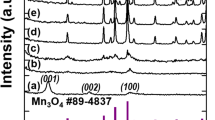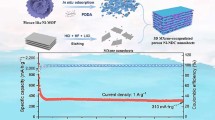Abstract
We report an efficient co-precitation and subsequent annealing chemical route to synthesize porous hierarchical Mn-doped NiCo2O4 nanosheet architectures. The as-synthesized products exhibit unique porous hierarchical structures. When tested as anode materials for lithium-ion batteries, the Mn-doped NiCo2O4 architectures show excellent performances of Li+ storage. Under a current density of 0.5 A g−1, 5% Mn–NiCo2O4 electrode is capable of retaining a specific capacity of 1428 mA h g−1 over 80 cycles. Even at 2 and 5 A g−1, comparable capacities of 1220 and 987 mA h g−1 could still be achieved, indicating a superior rate capability. Ex-situ XRD, HRTEM measurements reveal the electrochemical mechanism of NiCo2O4 architecture anode. On basis of above analyses, the excellent electrochemical performances of porous hierarchical Mn-doped NiCo2O4 nanosheet architectures should be ascribed to the following aspects. (1) The self-adsorbed 2D nanosheet hierarchical multilayer architectures are favorable to the infiltration of electrolyte and beneficial to the available space for lithium ion diffusion. (2) Mn doping and multiple nanosheets may synergistically enhance the electrical/ionic conductivity, reversible capacity, and mechanical stability of electrodes. (3) Porous continuous network structure can enlarge the contact area of Li2O and Ni, Co, CoO nanoparticles, thus improves the Li+ storage and rate performance of NiCo2O4 -based electrode.








Similar content being viewed by others
References
Y. Zhao et al., Recent developments and understanding of novel mixed transition-metal oxides as anodes in lithium ion batteries. Adv. Energy Mater. 6, 1502175 (2016)
M. Zheng et al., Hierarchically nanostructured transition metal oxides for lithium-ion batteries. Adv. Sci. 3, 1700592 (2018)
S.H. Yu et al., Conversion reaction-based oxide nanomaterials for lithium ion battery anodes. Small 12, 2146–2172 (2016)
A. Vu et al., Porous electrode materials for lithium-ion batteries-how to prepare them and what makes them special. Adv. Energy Mater. 9, 1056–1085 (2012)
M.S. Park et al., Porous nanoarchitectures of spinel-type transition metal oxides for electrochemical energy storage systems. Phys. Chem. Chem. Phys. 17, 30963–30977 (2015)
C. Yuan et al., Mixed transition-metal oxides: design, synthesis, and energy-related applications. Angew. Chem. Int. Ed. 53, 1488–1504 (2014)
S.G. Krishnan et al., Critical influence of reduced graphene oxide mediated binding of M (M = Mg, Mn) with Co ions, chemical stability and charge storability enhancements of spinal-type hierarchical MCo2O4 nanostructures. Electrochim. Acta 243, 119–128 (2017)
J. Li et al., High electrochemical performance of monodisperse NiCo2O4 mesoporous microspheres as an anode material for Li-ion batteries. ACS Appl. Mater. Interfaces 5, 981–988 (2013)
C. Yuan et al., Ultrathin mesoporous NiCo2O4 nanosheets supported on Ni foam as advanced electrodes for supercapacitors. Adv. Func. Mater. 21, 4592–4597 (2012)
L. Wang et al., Embedding NiCo2O4 nanoparticles into a 3DHPC assisted by CO2-expanded ethanol: a potential lithium-ion battery anode with high performance. ACS Appl. Mater. Interfaces 6, 10813–10820 (2014)
L. Shen et al., Mesoporous NiCo2O4 nanowire arrays grown on carbon textiles as binder-free flexible electrodes for energy storage. Adv. Funct. Mater. 24, 2630–2637 (2014)
Y. Chen et al., Reduced graphene oxide networks as an effective buffer matrix to improve the electrode performance of porous NiCo2O4 nanoplates for lithium-ion batteries. J. Mater. Chem. A. 2, 4449–4456 (2014)
J. Zhu et al., Ultrafine Au nanoparticles decorated NiCo2O4 nanotubes as anode material for high-performance supercapacitor and lithium-ion battery applications. Nano Energy 7, 114–123 (2014)
J. Xu et al., Facile synthesis of porous NiCo2O4 microflowers as high-performance anode materials for advanced lithium-ion batteries. Electrochim. Acta 145, 185–192 (2014)
G. Gao et al., Preparation of carbon-coated NiCo2O4@SnO2 hetero-nanostructures and their reversible lithium storage properties. Small 4, 432–436 (2015)
F. Zheng et al., Facile fabrication of porous NixCo3–xO4 nanosheets with enhanced electrochemical performance as anode materials for li-ion batteries. ACS Appl. Mater. Interfaces 6, 9256–9264 (2014)
E. Pomerantseva et al., Two-dimensional heterostructures for energy storage. Nat. Energy 2, 17089 (2017)
J. Li et al., Preparation and electrochemical performances of doughnut-like Ni(OH)2-Co(OH)2 composites as pseudocapacitor materials. Nanoscale 4, 4498–4503 (2012)
M. Yao et al., Wet chemical synthesis and magnetic properties of core-shell nanocolumns of Ni(OH)2@Co(OH)2 and their oxides. CrystEngComm 13, 2593–2598 (2011)
B. Cui et al., Core-ring structured NiCo2O4 nanoplatelets: synthesis, characterization, and electrocatalytic applications. Adv. Func. Mater. 18, 1440–1447 (2008)
O. Knop et al., Chalkogenides of the transition elements. VI. X-Ray, neutron, and magnetic investigation of the spinels Co3O4, NiCo2O4, Co3S4, and NiCo2S4. Canadian J. Chem. 46, 3463–3476 (1968)
C. Zhu et al., Facilely tuning porous NiCo2O4 nanosheets with metal valence-state alteration and abundant oxygen vacancies as robust electrocatalysts towards water splitting. Chem. Eur. J. 22, 4000–4007 (2016)
X. Zhou et al., One-dimensional NiCo2O4 nanowire arrays grown on nickel foam for high-performance lithium-ion batteries. J. Power Sources 299, 97–103 (2015)
C. Wang et al., Superior removal of arsenic from water with zirconium metal-organic framework UiO-66. Sci. Rep. 5, 16613 (2015)
X. Chen et al., Photoelectron spectroscopic investigation of nitrogen-doped titania nanoparticles. J. Phys. Chem. B 108, 15446–15449 (2004)
Audi et al., Valence-band X-ray photoelectron spectroscopic studies of manganese and its oxides interpreted by cluster and band structure calculations. Surf. Interface Anal. 33, 274–282 (2002)
Y. Mo et al., The sucrose-assisted NiCo2O4@ C composites with enhanced lithium-storage properties. Carbon 109, 616–623 (2016)
J. Xu et al., Rose flower-like NiCo2O4 with hierarchically porous structures for highly reversible lithium storage. J. Alloy. Compd. 684, 691–698 (2016)
K. Wang et al., PVD amorphous carbon coated 3D NiCo2O4 on carbon cloth as flexible electrode for both sodium and lithium storage. Carbon 125, 375–383 (2017)
W. Wang et al., A high-capacity NiCo2O4@ reduced graphene oxide nanocomposite Li-ion battery anode. J. Alloy. Compd. 741, 223–230 (2018)
Q. Ren et al., Enhanced electrochemical performance by size-dependent SEI layer reactivation of NiCo2O4 anodes for lithium ion batteries. Electrochim. Acta 297, 1011–1017 (2019)
W. Qiu et al., Surface phosphation of 3D mesoporous NiCo2O4 nanowire arrays as bifunctional anodes for lithium and sodium ion batteries. RSC Adv. 8(47), 26888–26896 (2018)
H.S. Jadhav et al., Facile and cost effective synthesis of mesoporous spinel NiCo2O4 as an anode for high lithium storage capacity. Nanoscale 6(17), 10071–10076 (2014)
W. Qiu et al., Tong. Surface phosphation of 3D mesoporous NiCo2O4 nanowire arrays as bifunctional anodes for lithium and sodium ion batteries. RSC Advances 8(47), 26888–26896 (2018)
J. Lu et al., Cobalt-doped Zn2GeO4 nanorods assembled into hollow spheres as high-performance anode materials for lithium-ion batteries. J. Mater. Chem. A 6(14), 5926–5934 (2018)
H. Zhao et al., The effects of Co doping on the crystal structure and electrochemical performance of Mg (Mn2–xCox)O4 negative materials for lithium ion battery. Solid State Sci. 39, 23–28 (2015)
Y. Ma et al., Fe-Doped MnxOy with hierarchical porosity as a high-performance lithium-ion battery anode. Adv. Mater. 25, 4646–4652 (2013)
C. Chen et al., Copper-doped dual phase Li4Ti5O12-TiO2 nanosheets as high-rate and long cycle life anodes for high-power lithium-ion batteries. ChemSusChem 8, 114–122 (2015)
Y. Xu et al., Two-dimensional V2O5 sheet network as electrode for lithium-ion batteries. ACS Appl. Mater. Interfaces 6, 20408–20413 (2014)
L. Hu et al., CoMn2O4 spinel hierarchical microspheres assembled with porous nanosheets as stable anodes for lithium-ion batteries. Sci. Rep. 2, 986 (2012)
P. Xiong et al., Two-dimensional nanosheets based Li-ion full batteries with high rate capability and flexibility. Nano Energy 12, 816–823 (2015)
J. Kan et al., Large and fast reversible Li-ion storages in Fe2O3-graphene sheet-on-sheet sandwich-like nanocomposites. Sci. Rep. 3, 3502 (2013)
K. Mondal et al., Mesoporous MnCo2O4 with a flake-like structure as advanced electrode materials for lithium-ion batteries and supercapacitors. Chem. Eur. J. 21, 1526–1532 (2015)
J. Jin et al., Hierarchy design in metal oxides as anodes for advanced lithium-ion batteries. Small Methods 2(11), 1800171 (2018)
S. Laruelle et al., On the origin of the extra electrochemical capacity displayed by MO/Li cells at low potential. J. Electrochem. Soc 149, A627–A634 (2002)
J.Y. Shin et al., Oxygen-deficient TiO2-δ nanoparticles via hydrogen reduction for high rate capability lithium batteries. Chem. Mater. 24, 543–551 (2012)
E. Ventosa et al., Ammonia-annealed TiO2 as a negative electrode material in Li-Ion batteries: n doping or oxygen deficiency? Chem. Eur. J. 19(42), 4194–14199 (2013)
Q. He et al., One-pot synthesis of self-supported hierarchical urchin-like Ni3S2 with ultrahigh areal pseudocapacitance. J Mater Chem A 6(44), 22115–22122 (2018)
Y. Zhang et al., Facile synthesis of porous Mn2O3 nanoplates and their electrochemical behavior as anode materials for lithium ion batteries. Chem. Eur. J. 20, 6126–6130 (2014)
Y. Su et al., Rational design of three layered TiO2@Carbon@MoS2 hierarchical nanotubes for enhanced lithium storage. Adv. Mater. 29, 371702724 (2017)
Y. Wang et al., Designed hybrid nanostructure with catalytic effect: beyond the theoretical capacity of SnO2 anode material for lithium ion batteries. Sci. Rep. 5, 9164 (2015)
D. Su et al., Mesoporous hexagonal Co3O4 for high performance lithium ion batteries. Sci. Rep. 4, 6519 (2014)
K. Rui et al., One-step solvothermal synthesis of nanostructured manganese fluoride as an anode for rechargeable lithium-ion batteries and insights into the conversion mechanism. Adv. Mater. 7, 1401716 (2015)
X. Yang et al., Interfacial optimization of g-C3N4-based Z-scheme heterojunction toward synergistic enhancement of solar-driven photocatalytic oxygen evolution. Appl. Catal. B 244, 240–249 (2019)
Acknowledgements
We acknowledge support from the project supported by the State Key Program of National Natural Science of China (No.: 51532005), the National Nature Science Foundation of China (Nos.: 51472148, 51272137), the National Youth Science Foundation of China (No.: 51702177), and the Tai Shan Scholar Foundation of Shandong Province.
Author information
Authors and Affiliations
Corresponding authors
Additional information
Publisher’s Note
Springer Nature remains neutral with regard to jurisdictional claims in published maps and institutional affiliations.
Electronic supplementary material
Below is the link to the electronic supplementary material.
Rights and permissions
About this article
Cite this article
Ma, J., Guo, E. & Yin, L. Porous hierarchical spinel Mn-doped NiCo2O4 nanosheet architectures as high-performance anodes for lithium-ion batteries and electrochemical reaction mechanism. J Mater Sci: Mater Electron 30, 8555–8567 (2019). https://doi.org/10.1007/s10854-019-01176-5
Received:
Accepted:
Published:
Issue Date:
DOI: https://doi.org/10.1007/s10854-019-01176-5




